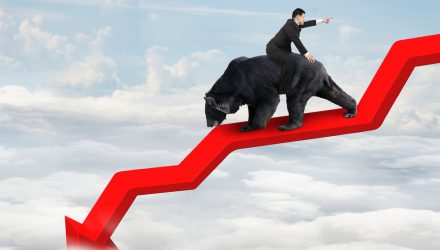The S&P 500 and related exchange traded funds slipped into bear market territory on Monday as investors bet on an increasingly aggressive Federal Reserve monetary policy outlook in face of surging inflationary pressures.
On Monday, the SPDR S&P 500 ETF (NYSEARCA: SPY), the iShares Core S&P 500 ETF (NYSEARCA: IVV), and the Vanguard 500 Index (NYSEARCA: VOO) each declined 2.9%. The ETFs are down about 20.9% since their early January 2022 highs.
If Monday’s losses hold, the S&P 500 benchmark will enter a bear market for the first time since 2020 — a bear market is defined by a 20% loss from a recent high.
U.S. equities have taken a beating this year as the Fed outlined plans to unwind accommodative post-pandemic policies, along with volatility associated with geopolitical risks. The most recent selling was attributed to data from Friday that revealed that U.S. consumer prices spiked 8.6% in May year-over-year, the fastest pace since 1981. Consequently, many anticipate that the Fed will quicken its pace of raising interest rates.
“The very fact that it overshot expectations has really frayed investors’ nerves even more and shown how difficult it is to try to keep a lid on inflation,” Susannah Streeter, senior investment and markets analyst at Hargreaves Lansdown, told the Wall Street Journal. “The worry is that inflation is getting too hot to handle for central banks and they’ll have to dose economies with cold water in the form of tighter policy.”
The Fed will start a two-day policy meeting on Tuesday, and most anticipate the central bank will announce on Wednesday a benchmark interest rate hike of half a percentage point. However, there are increased expectations that the Fed will move even more aggressively this year in response to Friday’s inflation update.
According to the CME Group, futures options revealed that traders are betting on an 81% chance that the Fed could hike interest rates by 2.5 percentage points before the end of the year, or half a percentage point hike at every Fed meeting this year.
“It seems as though inflation is staying for longer than expected,” Kiran Ganesh, a multiasset strategist at UBS, told the WSJ. “People are now beginning to fear that the Fed will have to go further or faster in terms of interest rates.”
For more news, information, and strategy, visit VettaFi.
